Noree Cosper's Blog, page 22
April 23, 2013
A-Z Blog Hop: Uriel
Uriel, whose name means “fire of God” or “God is my light” is one of the most important angels. He has been described as an archangel, a seraph, and a cherub. He is usually depicted as one of the four primary angels along with Michael, Gabriel, and Raphael. Though he’s not official by Catholic standards, he is in many Jewish texts.
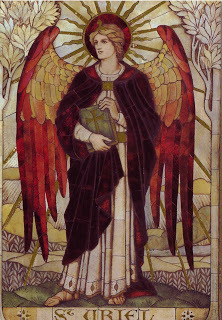
Uriel is portrayed as stern and punishing. According to Enoch he is the head of the seven archangels. He supposedly presides over Tartarus or Hell, where he punishes sinners by burning them in everlasting fire and hanging blasphemers by their tongues over unquenchable fires. And most people think angels are kind.But, Uriel is not all fire and brimstone. It was believed that Uriel gave the gift of the Qabalah to humanity, along with the Metatron. He led Abraham out of Ur and has interpreted prophecies for the good of humanity. He revealed heavenly mysteries to Ezra and has answer deep questions about evil and justice. He also serves as a guide to luminaries.
So, do you have a favorite angel?
Do you like stories about angels, demons, and the supernatural? Pick up a copy of "A Prescription for Delirium" available on Amazon, Barnes & Noble, and Smashwords.
Published on April 23, 2013 22:00
April 22, 2013
A-Z Blog Hop: Tree Ghosts
Trees have been a favorite haunting place for restless spirits. In northern India, shrines are built under trees to honor some of these spirits. In America a well know story is of Mrs. Linnie Jenkins and her crying pecan tree.
On April 12, 1981, Mrs. Linnie complained to her relatives of her pecan tree making awful noises. When her brother, sister-in-law, and others went to inspect the tree, they heard the crying sound but couldn’t find the cause. Some claimed the house was built on an ancient Indian burial site and the sound was of an Indian warrior spirit crying.
Word spread and the story was reported to the media. People came to stand in Mrs. Linnie’s yard just to listen to the tree. As the numbers grew Mrs. Linnie began charge a fee to discourage the crowds. It was reported that more than 5,000 people came to visit Mrs. Linnie’s pecan tree. Within a month the noise began to weaken and a copper tube was drilled into the tree the serve as a megaphone. The noise died altogether by April 30th.
Explanations were given, such as beetles or gasses produced by souring wood in the tree. One far-fetched one was that seals in a subterranean sea were making whimpering noises. However, no proof was given, so this remains a small mystery to this day.
 A Pecan tree photo by Carabou
A Pecan tree photo by CarabouHave you had any encounters with tree ghosts?
Do you like stories about angels, demons, and the supernatural? Pick up a copy of "A Prescription for Delirium" available on Amazon, Barnes & Noble, and Smashwords.
Published on April 22, 2013 22:00
April 21, 2013
A-Z Blog Hop: Sefer Raziel
The angel Raziel stands on the peak of Mount Horeb (where the Ten Commandments were given to Moses by God) and proclaims the mystical secrets to humankind. According to lore, the he created the first book ever written. The Sefer Raziel is made of sapphire or “angel’s tears” and is one of the most important texts on angel magic. It reveals secrets and mysteries of creation, including the wisdom of the 72 letters of the name of God and its 670 esoteric mysteries, and 1,500 keys, which were not even given to the angels. It also contains information on the five names of the human soul, the seven hells, the divisions of the Garden of Eden and the types of angels and spirits that have dominion over things in the world. Jealous angels coveted the Sefer Raziel and many thefts were attempted.
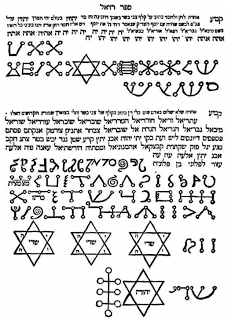 An excerpt of the Sefer Raziel
An excerpt of the Sefer RazielIn actuality, it is believed that the Sefer Raziel was written in the 13th century by different anonymous writers. The Jewish mystic Eleazar of Worms was believed to be one of them. In the Middle Ages, the book was highly revered and it was believed that mere possession of it would prevent fire. By the 19th century, there were 25 editions of it, though probably not in sapphire.
So you know of any old occult texts? Heh, can you tell me where I can get a hold of them, especially ones I precious gems?
Published on April 21, 2013 22:41
April 19, 2013
A-Z Blog Hop: Runes
Odin (Woden), the supreme god of the Norse pantheon wished to obtain mystical knowledge. He impaled himself on Yggdrasil, the World Tree with his own spear and hung there for nine days and nine nights. As he neared death, 18 runes appeared to him. As he grabbed the last one, he died. He decided to share the secret of runes once he was resurrected.
Runes have been used for a variety of magical work including healing, divination, charms, and spells. In the Dark Ages magicians inscribed spells made of runes on wands, swords, chalices, and stone tablets to accomplish whatever they desired. They could be used as amulets for protection or even inscribed on buildings. Runes also had the power to keep the dead in their grave, or to resurrect the dead. Divination was one of the most important uses. The runes were cast and their meanings were interpreted by readers. Because of this, runes were associated with the Norns, the three Fates of past present, and future.
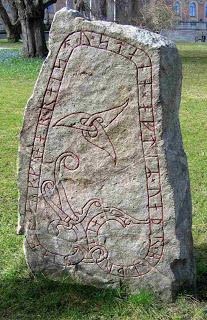
Runes were almost snuffed out along with other pagan practices during the 14th century when the Inquisition began their crusade. A law was passed in Iceland in 1639, forbidding anyone from using runes. If you did, you were considered a witch and treated accordingly.
German occultists revived interest in the early 20th century. They associated runes with racial supremacy. When the Nazis came to power, they adopted two runes that are now infamous: the swastika, the rune of Mother Earth and hammer of Thor, and the sig or S rune, which became the trademark for the SS.
Today runes are popular for divination, like tarot cards. Do you have a method of divination that you like?
Do you like stories about angels, demons, and the supernatural? Pick up a copy of "A Prescription for Delirium" available on Amazon, Barnes & Noble, and Smashwords.
Published on April 19, 2013 22:00
April 18, 2013
A-Z Blog Hop: Qabalah
As mention earlier this week, qabalah (kabbalah) is the mysticism of Judiaism. It was first used by a Spanish philosopher, Ibn Gabirol in the 11th century. It was founded on the Torah but is not an intellectual or ascetic discipline. Qabalh is the science of letters, the universal language from which all things were created. It creates words and sounds in ritual. According to a Qabalist, Franz Bardon, the kabbalist uses the science of letters and their spoken word becomes reality.
There are four overlapping branches of qabalah:
Classical or Dogmatic Qabalah: The study of the Torah and the central texts of the kabbalah.
The Practical Qabalah: Concerns magic, such as how to make talismans.
Literal Qabalah: Concerns the relationship between the letters of the Hebrew alphabet and numbers.
The Unwritten Qabalah: Concerns the study of the tree of life.
Of the four branches, the Practical, Literal, and Unwritten Qabalah have shaped the practice of Western magical ceremony along with Hermetic principles. The Tree of life is a ladder map that depicts the descent of the divine into the material world. Therefore, it shows the path a person can ascend to the divine while still in a mortal body. Each sephirah (step) is a state on consciousness and level of attainment of knowledge. The 10 different steps are arranged in groups for better understanding of their meanings. The Tree is split into three pillars, Mercy on right, Severity (also called the Tree of Knowledge) in the center, and Mildness on the left. All together, the Tree of Life comprises unity and creates the five dimensions: the three of the physical world, time, plus the spiritual world.
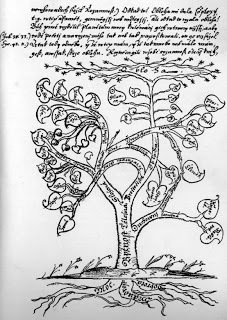 Tree of Life (US Public Domain)
Tree of Life (US Public Domain)In the magical part, each sephirah has associations an occultist must learn, such as magical tools, planets, chakras, sounds, perfumes, and tarot cards. The Tree of Life represents and alphabet of symbols that is the basis for a spiritual language that can be understood by humans, god, and angels. The symbols are used to invoke images subconsciously and to construct specific visions.
Has anyone ever used the qabalah, either alone or with other traditions?
Published on April 18, 2013 22:00
April 17, 2013
A-Z Blog Hop: Possession
A lot of people have visions of scenes of the Exorcist when they think of possession. Actually, most forms of possession are not demonic. It is the takeover of one’s body by a non-corporeal entity. Since ancient times, gods and other spirits have possessed people and interfered with human affairs. Possession is usually not wanted but many traditions view is as a great honor. Show here are some of the forms of possession.
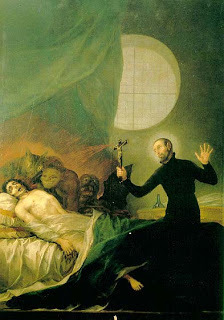 Demonic Possession:The demon takes up residence in a person’s body and controls (or at least influences) his or her thoughts, words, and actions. The demon can lay in hiding for periods of time, so the person seems normal and then the person will exhibit bizarre behavior. During these times the person in entranced and it may take time to return to normal. Usually, the person is under the sway of multiple demons. Demons stay in a person unless exorcised, causing strife and turmoil both in physical and mental health to the point of death, sometimes by suicide. According to the Catholic Church, possession can be caused by making pacts with the Devil or demons, playing with Oujia boards, or being the victim of a curse or spell. Signs of demonic possession are superhuman strength and levitation that is accompanied by fits, convulsions, or contortions, revulsion to holy objects, or knowledge of the future. It’s not just Christianity that holds to demonic possession, but cultures around the world believe it. It is a part of everyday life in Hinduism. The victim is usually a woman who sees her personal problems to be caused by evil spirits. In Japan, the kitsune, or fox fairies, are known to possess people. They will usually leave if offerings are made to them.
Demonic Possession:The demon takes up residence in a person’s body and controls (or at least influences) his or her thoughts, words, and actions. The demon can lay in hiding for periods of time, so the person seems normal and then the person will exhibit bizarre behavior. During these times the person in entranced and it may take time to return to normal. Usually, the person is under the sway of multiple demons. Demons stay in a person unless exorcised, causing strife and turmoil both in physical and mental health to the point of death, sometimes by suicide. According to the Catholic Church, possession can be caused by making pacts with the Devil or demons, playing with Oujia boards, or being the victim of a curse or spell. Signs of demonic possession are superhuman strength and levitation that is accompanied by fits, convulsions, or contortions, revulsion to holy objects, or knowledge of the future. It’s not just Christianity that holds to demonic possession, but cultures around the world believe it. It is a part of everyday life in Hinduism. The victim is usually a woman who sees her personal problems to be caused by evil spirits. In Japan, the kitsune, or fox fairies, are known to possess people. They will usually leave if offerings are made to them.Possession by Djinn:A Djinn will possess a human out of desire or on a whim. It will attack the weak, vulnerable, and insane. Djinn’s will also possess those they feel have wronged them. The Djinn will make people babble, have supernatural strength, and run unnaturally fast.
Possession by the Holy Ghost: After the Resurrection of Jesus, the apostles became possessed with the Holy Ghost. Flames appeared above their heads and they spoke in tongues they didn’t know. These types of possession are all voluntary and are considered a “religious altered state of consciousness.”
Spirit or Deity Possession:In many Non-Western cultures and shamanic traditions, voluntary possession is used to communicate with gods and spirits for help in solving problems or divining the future. Possession by a god shows the possessed is worthy of that god’s attention and is a great honor. Vodun is a good example of t religion that practices such acts. Their religious practices feature rites where the loas are invited to possess. The possessed lose all consciousness, completely becoming the loa.
Mediums: The fascination with the afterlife is still strong today. During the 19thcentury, the medium religious movement spread like wildfire. These people, believed to have the ability to contact the dead, would perform séances where they would give their bodies up to the dearly departed. Many of these were fake, but the practice still continues to a much lesser degree today.
Published on April 17, 2013 22:00
A-Z Blog Hop: Ornias
During the construction of Solomon’s Temple there was a workman’s boy who was tormented by a demon. Ornias, the demon, would appear at sunset and take half of the boy’s wages and food. Then, he’d suck his soul out of his thumb. Solomon noticed the by becoming sickly and asked him about it. Solomon prayed to god for the power over the demon. The archangel Michael gave Solomon a magic ring with a seal engraved upon it. “You shall imprison all the demons, male and female, and with their help you shall build Jerusalem when you bear this seal of God,” Michael told him.Solomon gave the ring to the boy and told him to fling it at the demon’s chest and order him to go to Solomon. The next sunset, Ornias appeared as fire and the boy threw the ring.“Come! Solomon summons you!” the boy shouted.Ornais screamed and promised riches if the boy would give the ring back to Solomon, but the boy refused. He bound the demon and delivered him to Solomon. The king found him at the gates and questioned him. Ornias claimed to have been an angel that fell from heaven and now resided in the constellation Aquarius. He explained that demons fly up to heaven to spy on god and fall when they grow exhausted, thus they are falling stars.
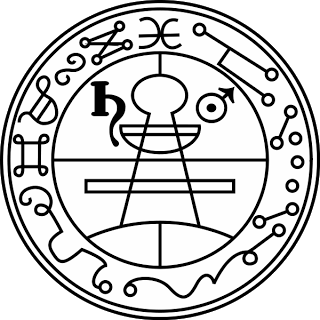
Solomon bound Ornias and forced him to cut stones from the quarry. He was the first of the demons that Solomon bound to build his temple. Nothing like demonic slavery to get the job done.In my series the Van Helsing Organization, the angels don’t dwell in the stars. They are a part of one of the Thrones of the Seven deadly sins.
Published on April 17, 2013 10:20
April 15, 2013
A-Z Blog Hop: Nephilim
Angels descended from heaven to watch over humanity. As they did this, their lust for human women grew and they bred with them. The result was the Nephilim, who were supposedly giants. Nephilim means “fallen” or “those who were cast down.” In Genesis 6:4, however, it’s suggested that the Nephilim were around before the angels descended. It states: “They were the mighty men that were of old, the men of renown.”
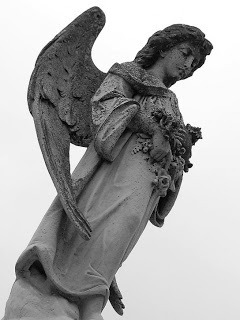
God grew angry at the corruption that spread from cohabitation of angels and man. He decided to destroy not only the humans but all life on earth. He chose Noah and his family alone to survive the Flood. And it rained for forty days and forty nights.
However, not all the Nephilim perished. They have been mentioned throughout other books in the bible. In numbers that are the Anakim, so big that the men are like grasshoppers. Enoch 15:8-9 states that they shall be called evil spirits on earth and they will dwell both on earth and in the earth, making them demons.
Nephilim play a large part in the book I’m currently writing (Book 2 of the Van Helsing Organization) but they are not the giants as mentioned in the bible. Nor are they evil. They can be the children of angels, but some can also be considered the children of other pantheons. The Greek heroes would have been Nephilim in my mythology.
Do you like stories about angels, demons, and the supernatural? Pick up a copy of "A Prescription for Delirium" available on Amazon, Barnes & Noble, and Smashwords.
Published on April 15, 2013 22:00
April 14, 2013
A-Z Blog Hop: Magic
The word magic is common in our age; for me it’s more common than for others. But it means different things to different people. Most view it as fantasy or fraud, only to be ridiculed. Others hold to the tradition that it is the heart of all esoteric traditions and is found in religious teaching. Here are some of the ancient traditions that gave Western magic its roots.
Assyrian/Babylonian Magic: So this is close to where it all began. Humans began with offering prayers up to spirits or gods for protections. Incense, whispers and chants were often used in conjunction to this. When they began to get results the practice became more refined. They expressed the power in the natural word such as stones and in the stars themselves. Gods were attributed to celestial bodies and used in forms of magic. To them, magic was complete order, there were no accidental happenings. Numbers played an important part in their magic. In fact the tower of Babylon was built with specific specifications. You traveled through seven steps, of stages of wisdom and knowledge. One you finished the final stage you could obtain the eighth stage, which was the eternal and divine.
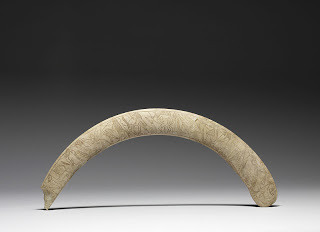 Egyptian Wand showing the procession of godsEgyptian Magic: This was a major development in most Western Traditions. It was practiced by priests and included the arts of spell casting, divination, necromancy, making talismans and amulets, and magic in medicine. The Egyptians believed that illness was the cause of demons and thus the cures involved exorcisms. One of the most important parts of Egyptian magic was the proper use of words and names of power. Most incantation involved a string of names, not all of them in the same language.
Egyptian Wand showing the procession of godsEgyptian Magic: This was a major development in most Western Traditions. It was practiced by priests and included the arts of spell casting, divination, necromancy, making talismans and amulets, and magic in medicine. The Egyptians believed that illness was the cause of demons and thus the cures involved exorcisms. One of the most important parts of Egyptian magic was the proper use of words and names of power. Most incantation involved a string of names, not all of them in the same language.Greek and Roman Magic: In a culture that thrived on gods, daimones (spirits), celestial intelligences, and the dead, magic was rich in Greece and Rome. Their magic was of sympathetic bonds that enabled magic at a distance. It was the Hermetic principle “As above, so below” which means that the microcosm reflects the macrocosm. Though all magic arts were practiced, the Greeks devoted great attention to destiny, the prophecy of oracles, and astrology. Both Greeks and Romans practiced divination and Oneiromancy, the magic of dreams. Thurgia was an exalted form of magic that that had religious overtones and was akin to ritual magic. Many practitioners believed that through Thurgia, they could bring divine powers to earth and ascend their souls to heaven.
Jewish Magic: Most of the magic was borrowed and adapted from other cultures such as the Canaanites, Babylonians, and Egyptians .Most of it was concerned with protection from demons and gaining blessings. Most of the magic was attributed to the wisdom of King Solomon which was the basis for the Key of Solomon, one of the most important handbooks for Western Magic. Angels were belived to be the ones who taught humans magic, mainly the Watchers. The magic was organized into systems to conform to Old Testament laws forbidding sorcery. The names of God and angels were incorporated into the incantations. This later became the Kabbalah or Qabalah.
 Symbol from the Key of Solomon
Symbol from the Key of SolomonThere are many, many more magical traditions out there. Many borrow and build on the others until we have what is Western magic today. You can say that Wicca practices a mix between high magic (ritual or ceremonial magic) and natural magic (magic using herbs, metals, stones and such), while, from what I understand, orders such as the Golden Dawn stick more to high magic.
Do you have a favorite magic tradition?
Do you like stories about angels, demons, and the supernatural? Pick up a copy of "A Prescription for Delirium" available on Amazon, Barnes & Noble, and Smashwords.
Published on April 14, 2013 22:00
April 12, 2013
A-Z Blog Hop: Lycaon
So, I was going to do lycanthropy today, but I changed my mind when I read about this myth. You see, I love Greek and Roman Mythology. OK, I love lot of mythology, but they would be my favorite. Today’s post still has to do with wolf-men. It’s the story of Lycaon.
This story comes from Ovid’s Metamorphoses. You see, Jupiter (Zeus) was angered at the murder of Julius Caesar and the increasing wickedness of the human race. So, he did what he was known to do. He took a human guise and traveled around to check on the state of affairs. One night he entered the home of King Lycaon who was known to be an inhospitable tyrant. Jupiter revealed himself as a god and the people bowed to him, except for Lycaon, who laughed in disbelief. He proposed a test to determine if Jupiter was truly a god.
Lycaon took a hostage that had been sent to him by the Molossian people and killed him. He then cooked and served his limbs as food for the god. When Jupiter saw this he became enraged and destroyed the entire house with fire. Lycaon escaped the flames, but not Jupiter’s wrath. For his crime, the Lycaon was turned into a werewolf. Ovid describes his change as:
“There he uttered howling noises, and his attempts to speak were all in vain. His clothes changed into bristling hairs, his arms to legs, and he became a wolf. His own Lycaon savage nature showed in his rabid jaws, and he now directed against the flocks his innate lust for killing. He had a mania, even yet, for shedding blood. But, though he was a wolf, he retained some traces of his original shape. The greyness of his hair was the same, his face showed the same violence, his eyes gleamed as before, and he presented the same picture of ferocity.”
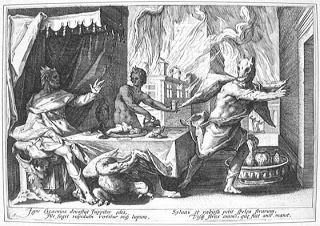
This myth is possibly connected to the cannibalism practiced in the cult of Jupiter Lycaeus. The cult believed a person who ate human flesh was turned into a wolf and spent ten years in the wild. Afterwards, they could take human form, but only if they consumed no more human flesh. This is a pretty interesting myth for where werewolves came from.
Do you know any myths in other cultures about the origins of werewolves?
Do you like stories about angels, demons, and the supernatural? Pick up a copy of "A Prescription for Delirium" available on Amazon, Barnes & Noble, and Smashwords.
Published on April 12, 2013 22:00



